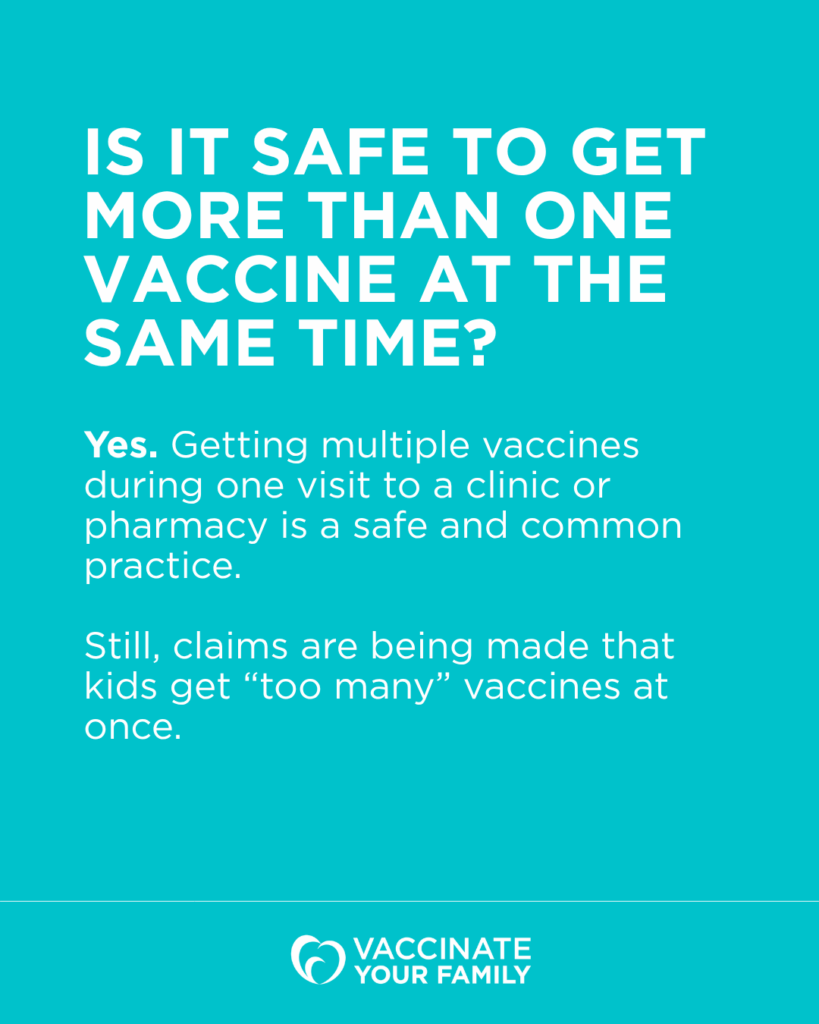Here’s How We Know It’s Safe to Get Multiple Vaccines at Once
The newly established Advisory Committee on Immunization Practices (ACIP) Childhood and Adolescent Immunization Work Group has announced plans to examine concurrent immunization administration—when multiple vaccines are given during the same visit.
Learn more about the Work Group and its other priorities including its review of aluminum adjuvants.
What is concurrent administration and what are the benefits?
Concurrent administration, also called coadministration or simultaneous administration, means giving more than one vaccine during a single clinical visit.
According to the Centers for Disease Control and Prevention (CDC) website as of fall 2025, “giving more than one vaccine at the same clinical visit is preferred because it helps keeps patients up to date.” Some children and families face challenges getting to appointments; fewer follow-up visits are needed when vaccines are coadministered, allowing more children to receive vaccines on time, which keeps them safe at social gatherings, school, and daycare.
The American Academy of Pediatrics also supports administering multiple vaccines in one visit, noting that “infants and children have sufficient immunologic capacity to respond to multiple vaccine antigens administered at the same time”. Receiving multiple vaccines in one visit is also safe for adults.
Giving multiple vaccines in one visit has many benefits including:
- More on-time vaccinations to keep kids and adults safe
- Higher rates of vaccine coverage in communities
- Fewer health care visits for families
This means more protection from dangerous diseases in less time.
Can multiple vaccines given at the same time “overwhelm” my child’s immune system?
No. Children’s immune systems are exposed to more antigens every day than from the entire childhood vaccine schedule combined. From the time they’re born, babies’ immune systems have been fighting off bacteria and viruses constantly.
As technology and innovation have improved, the current immunization schedule allows children and adolescents to be protected from more diseases, while receiving even smaller amounts of vaccine components. In 1960, children were exposed to more than 3,200 immunogenic proteins (which is a protein that causes an immune response in the body) in the combined total of the recommended vaccines at that time, today that number is down to about 150.
How do we know this is safe?
Before any vaccine is approved for use, the Food and Drug Administration (FDA) requires it to go through careful safety testing. One important step is called a “concomitant use study,” which means the new vaccine is tested along with other vaccines that children usually get. These studies make sure that giving several vaccines at the same visit is safe and doesn’t impact how well they work. Because this kind of testing has been done for many years, we have lots of evidence showing that children can safely receive multiple vaccines at once.
The Institute of Medicine Report
Concerns about coadministration aren’t new, and comprehensive research has answered these questions before. In 2013, the Institutes of Medicine (IOM) published a landmark report after investigating the safety of the childhood immunization schedule.
This report is the most comprehensive examination of the immunization schedule to date. The IOM authoring committee “uncovered no evidence of major safety concerns associated with adherence to the childhood immunization schedule”. The report also offers a framework for conducting safety research should signals arise that indicate that there may be need for investigation.
Over and over again, the evidence we have confirms that the risks of concurrent administration, as recommended in the current childhood vaccination schedule, are low and the benefits of vaccination outweigh any risk of adverse events.
Why is the ACIP re-examining concurrent vaccine administration?
Claims are circulating about “too many” vaccines being given to children, but there is no safety or medical reason not to give certain vaccines in the same visit. No new safety signals have been flagged that have led to this investigation.
The traditional role of the ACIP is to review vaccines as new information becomes available: when a new vaccine is coming to market, clinical trial evidence suggests expanding a vaccine to a new age group, or when there is a safety signal that requires further investigation.
If the ACIP were following the traditional process of the Evidence to Recommendations (EtR) framework, the first question they need to answer would be “is the problem of public health importance?”
Concurrent administration has not created a problem of public health importance. Instead, it leads to higher vaccination coverage rates, which in turn support both public health and the health of individual children.
Ongoing, gold standard science to understand vaccine safety and effectiveness is essential, especially when it is in response to a new disease threat or a flagged vaccine safety concern.
Revisiting settled science, however, creates confusion and undermines professional medical recommendations. Calling into question the childhood immunization schedule without any evidence threatens to erode vaccination coverage rates as well as an individual’s ability to make informed decisions about how to best protect themselves and/or their children from vaccine-preventable diseases.
Questioning the practice of giving multiple vaccines at one visit – for no safety or medical reason – will not make America healthier.
Read more about why CDC and ACIP must adhere to evidence-based recommendations here.
Social media sharing:
Please help share this important information! These social-ready graphics are downloadable. Here’s a suggested caption (or write your own!) → It is safe and common for kids (and adults) to get more than one vaccine at the same time. It doesn’t overwhelm the immune system. Children’s immune systems are exposed to more antigens every day than from the entire childhood vaccine schedule combined. From the time they’re born, babies’ immune systems have been fighting off bacteria and viruses constantly. And unlike the viruses and germs we’re exposed to in the real world, vaccines are studied alongside the other vaccines in the schedule before they’re approved.

